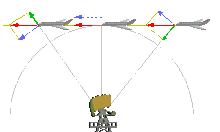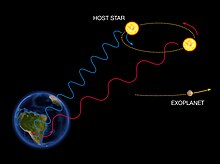Radial velocity

The radial velocity or line-of-sight velocity of a target with respect to an observer is the
The radial speed or range rate is the
In astronomy, the point is usually taken to be the observer on Earth, so the radial velocity then denotes the speed with which the object moves away from the Earth (or approaches it, for a negative radial velocity).
Formulation
Given a differentiable vector defining the instantaneous
Let the instantaneous relative velocity of the target with respect to the observer be
| (1) |
The magnitude of the position vector is defined as in terms of the
| (2) |
The quantity range rate is the time derivative of the magnitude (norm) of , expressed as
| (3) |
Evaluating the derivative of the right-hand-side by the chain rule
using (1) the expression becomes
By reciprocity,[1] . Defining the unit relative position vector (or LOS direction), the range rate is simply expressed as
i.e., the projection of the relative velocity vector onto the LOS direction.
Further defining the velocity direction , with the
where the inner product is either +1 or -1, for parallel and
A singularity exists for coincident observer target, i.e., ; in this case, range rate is undefined.
Applications in astronomy
In astronomy, radial velocity is often measured to the first order of approximation by
Spectroscopic radial velocity
Light from an object with a substantial relative radial velocity at emission will be subject to the
The radial velocity of a star or other luminous distant objects can be measured accurately by taking a high-resolution spectrum and comparing the measured wavelengths of known spectral lines to wavelengths from laboratory measurements. A positive radial velocity indicates the distance between the objects is or was increasing; a negative radial velocity indicates the distance between the source and observer is or was decreasing.
William Huggins ventured in 1868 to estimate the radial velocity of Sirius with respect to the Sun, based on observed redshift of the star's light.[6]

In many
Detection of exoplanets

The radial velocity method to detect exoplanets is based on the detection of variations in the velocity of the central star, due to the changing direction of the gravitational pull from an (unseen) exoplanet as it orbits the star. When the star moves towards us, its spectrum is blueshifted, while it is redshifted when it moves away from us. By regularly looking at the spectrum of a star—and so, measuring its velocity—it can be determined if it moves periodically due to the influence of an exoplanet companion.
Data reduction
From the instrumental perspective, velocities are measured relative to the telescope's motion. So an important first step of the data reduction is to remove the contributions of
- the Earth's elliptic motion around the Sun at approximately ± 30 km/s,
- a monthly rotation of ± 13 m/s of the Earth around the center of gravity of the Earth-Moon system,[9]
- the daily rotation of the telescope with the Earth crust around the Earth axis, which is up to ±460 m/s at the equator and proportional to the cosine of the telescope's geographic latitude,
- small contributions from the Earth polar motion at the level of mm/s,
- contributions of 230 km/s from the motion around the Galactic Center and associated proper motions.[10]
- in the case of spectroscopic measurements corrections of the order of ±20 cm/s with respect to aberration.[11]
- Sin i degeneracyis the impact caused by not being in the plane of the motion.
See also
- Proper motion – Measure of observed changes in the apparent locations of stars
- Peculiar velocity – Velocity of an object relative to a rest frame
- Relative velocity – Velocity of an object or observer in the rest frame of another object or observer
- Space velocity (astronomy)– Study of the movement of stars
- Bistatic range rate
- Doppler effect
- Inner product
- Orbit determination
- Lp space
Notes
- obtuse angleor if relative velocity (green arrow) and relative position are antiparallel.
References
- ISBN 0135367972.
- ^ Resolution C1 on the Definition of a Spectroscopic "Barycentric Radial-Velocity Measure". Special Issue: Preliminary Program of the XXVth GA in Sydney, July 13–26, 2003 Information Bulletin n° 91. Page 50. IAU Secretariat. July 2002. https://www.iau.org/static/publications/IB91.pdf
- ^ S2CID 16012160. Retrieved 4 February 2017.
- Bibcode:1999A&A...348.1040D.
- ^ Resolution C 2 on the Definition of "Astrometric Radial Velocity". Special Issue: Preliminary Program of the XXVth GA in Sydney, July 13–26, 2003 Information Bulletin n° 91. Page 51. IAU Secretariat. July 2002. https://www.iau.org/static/publications/IB91.pdf
- .
- S2CID 2756148.
- S2CID 73533931.
- )
- S2CID 119219962.
- Bibcode:1985A&A...144..232S.
Further reading
- Hoffman, Kenneth M.; Kunzel, Ray (1971), Linear Algebra (Second ed.), Prentice-Hall Inc., ISBN 0135367972
- Renze, John; Stover, Christopher; and Weisstein, Eric W. "Inner Product." From MathWorld—A Wolfram Web Resource.http://mathworld.wolfram.com/InnerProduct.html
















